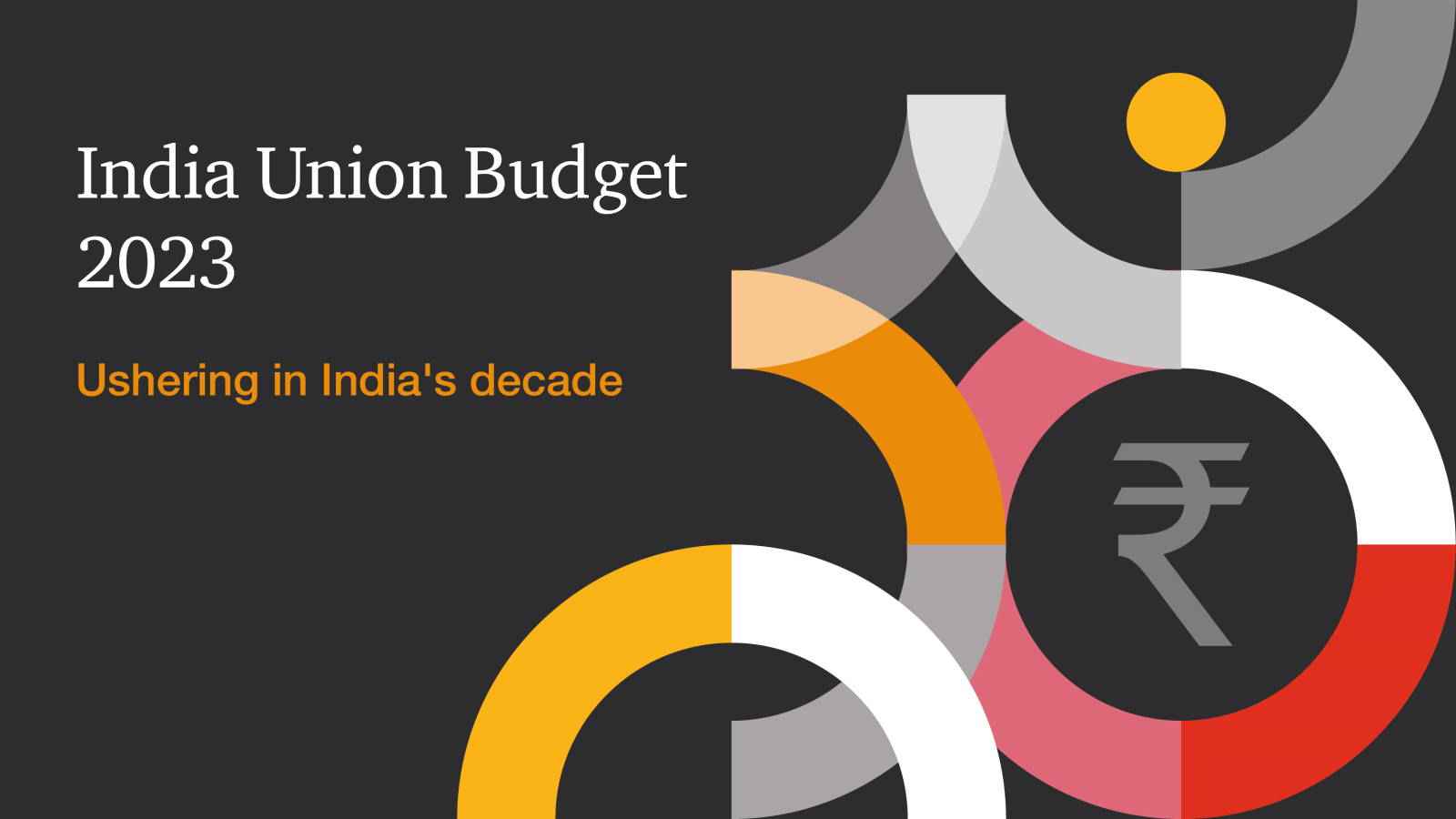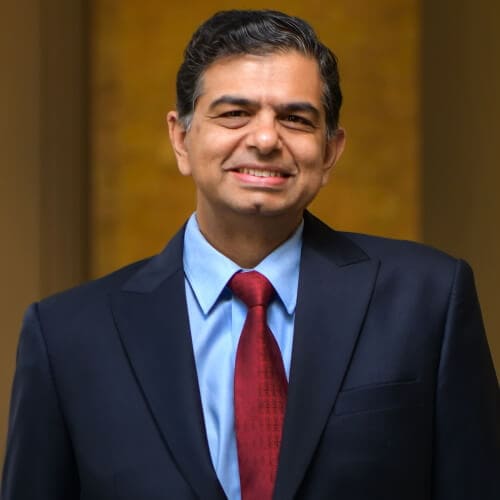
Featured - 3 items

Why energy transition is the need of the hour
by Amit Kumar, Partner and Leader - Power & Utilities, Mining
#Budget2023 with PwC
Union Budget 2023–24, presented by Finance Minister Nirmala Sitharaman, builds on the vision set out in the previous budgets and provides a blueprint for steering the economy towards a sustained high-growth trajectory in the 25-year-long lead-up to India @100.
Our experts at PwC India share industry expectations from the budget announcement. This page showcases budget forecasts, budget explanations and will decode the Budget on February 1. Explore this page to catch up on the Budget 2023 expectations from industry stakeholders, Union Budget 2023 analysis as well to get a better understanding of the budget implications on the Indian Economy.

Union Budget 2023-24 Analysis (PDFs)
Ushering in India's decade: Union Budget 2023-24
This Budget has provided a blueprint for fueling India’s aspirations and expectations as the country commences its journey towards India@100. Explore our analysis and understand the implications on your business.
Union Budget 2023-24: Key proposals for the Financial Services Sector
Budget 2023 lays the foundation for the Prime Minister’s vision of India@100 by adopting seven priorities including, inter alia, Infrastructure and Investment, Inclusive Development and Financial Sector.
Webcasts
Register for PwC’s Budget analysis for startups and VCs
Analyse the impact of the Union Budget 2023 on the Startup and Venture Capital ecosystem
Day and date: Thursday, Feb 2 2023

Time: 6:30 AM - 7:30 AM (UTC-05:00) Eastern Time (US & Canada)
Register here.
Moderator |
Panelists |
|||
| Bhavin Shah Partner and leader, Deals |
Harshal Kamdar CFO, Sequoia |
Amit Jhunjhunwala CFO, Accel |
Vaibhav Goel CFO, Elevation |
Amit Mehra CFO, Lightspeed |
Reactions to Budget 2023-24
Videos
Pre-budget expectations for renewable energy
How a skill-linked incentive scheme can create new age jobs
Pre-Budget 2023–24 expectations
1. Tax rates rationalisation
- A reduced rate of 15% may also be made applicable to existing companies engaged in focus sectors for which Production Linked Incentives (PLI) Scheme have been announced.
- Sunset clause to commence manufacturing activities for companies availing concessional tax rate regime of 15% may be extended from 31 March 2024 for an additional two years.
2. Providing tax certainty
The government may provide guidance around the methodology to be followed for computation of profit attributable to non-residents those of who constitute significant economic presence in India.
There are several building blocks to be finalised in Pillar One of the OECD/ G20 Inclusive Framework. However, the OECD has moved at a rapid pace in case of Pillar Two with the announcement of the rules and commentary. We might see some announcements related to India’s plan to implement Pillar Two in this Budget.
- New mechanism for faster dispute resolution, such as mediation, may be brought in.
3. Spurring investment and demand
Concessional tax rate or tax holiday for electric vehicles, green technology or clean energy, and semi-conductors can be introduced.
Increase in deduction under section 80C of the Income-tax Act, 1961 (the Act) limit and for interest on home loan.
- Rationalisation of the capital gains tax regime by bringing in parity for debt mutual funds and listed debentures with their equity counterparts.
4. Ease of doing business
To boost exports from India and support working capital requirements, exports may be removed from the purview of section 194-O of the Act.
- Relaxation of deemed dividend provisions under section 2(22)(e) of the Act by excluding transactions in compliance with section 186 of the Companies Act, 2013 which may be subject to certain safeguards such as repayment of loan in a specified time limit and payment of interest at arm’s length rate.
5. Other key expectations from the Budget on corporate tax
Extension of the sunset clause for sections 194LC and 194LD of the Act.
Eligibility of section 194R of the Act for lower deduction certificate under section 197 of the Act.
Tax deducted at source framework for the online gaming sector may be brought in to ensure that the government has the necessary transaction trail.
1. Rationalisation of SHR
- Safe Harbour Rules (SHR) should be revised to rationalise the current margins, increase or remove turnover thresholds and reduce the number of service classifications. Learnings from the Advance Pricing Agreement program and Income-tax Appellate Tribunal or court rulings can be leveraged in this regard.
- SHR maybe augmented to cover other forms of business activity such as marketing support and distribution activity and extended to cover contract R&D in relation to all activities (not just limited to software development services and generic pharmaceuticals).
- The rationalisation of SHR would substantially reduce transfer pricing (TP) litigation in India.
2. Introduction of block assessment for TP assessments
- A block assessment of three to five years should be considered for TP cases in line with the global best practices followed by many developed countries such as the US, Germany and Australia.
- The frequency of the assessment cycle and the number of years to be covered in the block may be determined based on the past compliance behaviour of the taxpayer and risk assessment parameters.
- Introduction of block assessments would go a long way in freeing up the time and resources of the tax department, improve the quality of TP audits and reduce potential litigation.
3. Self-declaration of international transactions by taxpayers
- The TP provisions should be suitably amended to provide for self-declaration of international transactions by the taxpayer and dispense with the need for the accountant’s report in Form 3CEB.
- The requirement of an accountant’s report creates an additional burden on the taxpayer and increases the cost of compliance. Accordingly, dispensation of the filing of an accountant’s report will be in line with the government’s approach to encourage trust building and improve ‘Ease of Doing Business’.
1. GST
- Clarification on taxability
- A circular should be issued clarifying the taxability in the case of expatriates deputed or seconded to India for the purpose of Indian companies’ business. The reimbursement of salaries paid by the foreign company, payment of salaries directly to the expats by the Indian entities should not be treated as consideration for ‘Manpower Supply’ service as long as the expats are wholly engaged by the Indian company during the period of secondment and are on the payroll as employees of the Indian entity. Moreover, relief by way of allowing service tax paid as transitional credit and waiver of interest should also be provided.
- Crypto currencies should be classified as ‘securities’ and accordingly be exempt from taxability.
- The Budget on indirect tax should provide clarity on the taxability of ‘online gaming’ transactions on the applicable rate of tax and the non-inclusion of prize money in the value of service.
- Clarification to be provided on the taxability of discounts, incentives, voucher and reward point transactions.
- Clarification should be provided regarding the scope of activities provided by a person (other than individuals) to its members or constituents that are taxable under sub-section (aa) to section 7 of the Central Goods and Services Tax Act, 2017 (CGST Act).
- A circular should be issued clarifying the taxability in the case of expatriates deputed or seconded to India for the purpose of Indian companies’ business. The reimbursement of salaries paid by the foreign company, payment of salaries directly to the expats by the Indian entities should not be treated as consideration for ‘Manpower Supply’ service as long as the expats are wholly engaged by the Indian company during the period of secondment and are on the payroll as employees of the Indian entity. Moreover, relief by way of allowing service tax paid as transitional credit and waiver of interest should also be provided.
- Ease of doing business
- Clarity on the applicability of cross charge and ISD mechanism
- In cases where favourable circulars have been issued, it needs to be clarified that the earlier negative AARs issued on the subject should not be binding and that the circulars prevail over the AARs and are binding on the officers.
- Section 2(6)(v) should be deleted, and Circular No. 161/17/2021-GST dated 20 September 2021 should be modified to provide that any services supplied by an establishment in India to its establishment outside India should be accorded export status.
- Petroleum products and electricity may also be brought under GST at an early date so as to allow input tax credit (ITC) thereon without a break in the chain of credit.
- ITC restrictions on regular business expenditures such as CSR activities and health insurance should be removed.
- Clarification should be issued to allow ITC credit on demo cars.
- The order of utilisation prescribed in the GST law should be eliminated to allow free utilisation of ITC from any head (except utilisation of CGST for the payment of SGST and vice versa).
- Deemed credit (ITC allowed up to a permissible capping, say 98%) on all business expenditure can be introduced to eliminate the consequences of blocked credit under section 17(5) of the CGST Act.
- Refund-related aspects
- Cash refund of the credit in balance at the time of closure of the unit or surrender of registration to be allowed.
- GST law to be amended to include the refund of input services under the ambit of the inverted duty structure refund.
- Section 142(8) of the CGST Act, which disallows credit of taxes recovered pursuant to proceedings, to be either deleted or amended so as to allow refund of such taxes paid under RCM but confirmed after the introduction of GST.
- A clarification on the ‘relevant date’ for the purpose of section 54 of the CGST Act on account of any refund arising pursuant to an Advance Ruling should also be provided.
- The accumulated balances at the end of each year may be refunded or carried forward at the option of the taxpayer.
- Exporters to be entitled to refund all input taxes paid, even if the credit thereof is ineligible, and suitable clarification to be issued. This would be in line with the government’s objective not to export taxes.
- Compliances
- Once the condition of reporting outward supplies in Form GSTR-1 to avail ITC is fulfilled (section 16(2)(aa) of the CGST Act), there should not be another requirement to fulfil whether the supplier has paid the tax to the government or not (section 16(2)(c) of the CGST Act) since it is highly impossible for the recipient to trace the same.
- It should be clarified that if the credit is reflected in Form GSTR-2B, the recipient can avail such credit in any later month before the expiry of the prescribed period (30 November of the following FY).
- Guidelines should be issued to direct the Revenue authorities to exercise the powers of blocking the electronic credit ledger (rule 86A of the Central Goods and Services Tax Rules, 2017) only where there is proper reason to believe that fraudulent or ineligible credit has been availed, by recording reasons and providing opportunity of hearing.
- Given the adequate penal and anti-abuse provisions within the GST legislative framework, offences under GST should be decriminalised.
- Others
- Amnesty schemes should be extended to provide relief by way of waiver of interest arising in the case of genuine interpretational and operational issues remaining unsettled and awaiting finality before High Courts and the Supreme Court.
- A general GST amnesty scheme may also be introduced considering that the law is new and interpretative. This can help in reducing litigation.
- An appellate remedy from the rulings passed by the AAAR should be provided.
- A notification should be issued with respect to the constitution of the GST Appellate Tribunal.
2. Customs
- MOOWR
- Conversion of EOU(s) to Manufacturing and other Operations in Warehouse Regulations, 2019 (MOOWR) Scheme may be considered.
- Benefit of depreciation may be provided for duty payment at the time of removal of capital goods.
- Authorised Economic Operator (AEO) certificate holders (Tier 2 and 3 status holders) may be given priority in granting MOOWR licenses, with a time bound approval in 30 days.
- Clear guidelines or procedure and compliances may be laid out vis-à-vis specified operations that may be allowed.
- RoDTEP scheme
- Inclusion of EOUs and SEZs under the RoDTEP Scheme.
- SEIS
- New scheme to replace Service Export from India Scheme (SEIS), or any other scheme designed for service exporters as extended to the manufacturing sector under sector-specific PLI schemes may be introduced.
- SEIS benefit for some services such as management consultancy services, services related to management consulting, technical testing and analysis services and cargo handling services may be continued after inviting comments from stakeholders.
- AEO Scheme
- Legal compliances for obtaining AEO certification may be diluted.
- Process for renewal of AEO status may be simplified.
- Duty deferment benefit presently available for a fortnight to AEO Tier 2 and Tier 3 may be extended to AEO Tier 1. Alternatively, for AEO Tier 2 and Tier 3, option to have a ledger may be considered where duty payable can be offset against refunds, rebates or scrips admissible to them.
- Customs duty refund, re-export drawback and band rate fixation may be fast tracked from processing of application to grant of refund and should be granted in 30 days with provisional grant within 15 days subject to the submission of a complete application.
- Amendments to shipping document may be allowed without any fee or concessional fee and to be completed within a maximum of 24 hours of filing the request.
- Interest-free period for storage of goods in bonded warehouse may be increased from 90 days to 180 days.
- No confiscation or seizure of goods in case of investigation unless approved by the AEO Programme Manager in consultation with the Chief Commissioner.
- Section 17 of the Customs Act, 1962
- Clarification may be provided to treat self-assessed bill of entry as an assessment order.
- Section 149 of the Customs Act, 1962
- Amendment on common portal through customs automated system which has been permitted to be operationalised.
- Refund of excess duty paid as a consequence of amendment to bill of entry to be allowed suo motto subject to compliances.
- Supplementary export benefits in case of amendment of FOB value etc.
- In case of requirement to pay incremental customs duty with interest due to amendment to bill of entry, credit of IGST should be permitted on the incremental duty paid, for which the procedure and specific document may be prescribed.
- No Show Cause Notice or Pre-Consultation Notice should be issued where amendment to the bill of entry request is resulting in refund of duty, claim of exemption, etc.
- Classification and consequent claim of exemption on IT or electronic goods
- Matter should be technically examined vis-à-vis past guidance and suitable clarification and guidance should be issued to field formations, including on the demand notices or consultative letters issued.
- Advance Rulings and amnesty scheme
- Advance Ruling now has a validity of three years unless there is a change in law or in the facts based on which it is pronounced. However, no guidance on modalities is laid down on the fate of the ruling where there is no change in the law or facts – guidelines and process e.g. a self-declaration by the applicant seeking extension of the ruling for a specified period can be considered and can be further extendable at the option of the importer if there is no material change with the timelines for filing such request.
- An amnesty scheme can be introduced under customs for providing opportunity to taxpayers to clear past baggage and reduce litigation.
1. Rate rationalisation
- Tax rate for resident investors may be harmonised at par with non-resident investors, i.e. at 10%, without indexation – at least on the transfer of unlisted shares issued by start-ups.
- Concessional tax regimes may be introduced for partnership firms and LLPs as well.
- The rate of minimum alternate tax for eligible start-ups may be reduced from the existing 15% to 9% (at par with IFSCs).
2. Providing tax certainties
- Carve out should be provided for intra-group reorganisations in section 79 of the Income-tax Act, 1961 (the Act), which otherwise impacts the carry forward and set-off of losses.
3. Ease of doing business
- Specific provisions along with relevant tax exemptions may be introduced for the merger of LLPs into companies.
- Appropriate amendments to be made in the Act to provide tax neutrality in relation to outbound mergers.
- Deduction for cost of goodwill under sections 50B and 55 of the Act to be allowed for acquisition through any mode and not restricted to acquisition through purchase.
- Similar to orders by the AAR, orders of the Board of Advance Ruling should also be made binding on the applicant and the tax department.
- Deferral of tax on the employee stock option plan under section 191 of the Act in the hands of the employees should not be restricted to the employees of start-ups referred to in section 80-IAC of the Act but should be extended to the employees of any start-up.
- To encourage rapid consolidation and growth and to make India a competitive country in the services sectors, the benefit under section 72A of the Act should be extended to service industries (non-industrial undertakings).
4. Going global
- Exemption should be provided to the shareholder in case of indirect transfer of shares of the Indian company resulting from merger or demerger of foreign companies.
- Clarity may be provided with respect to the overseas payments attracting equalisation levy and withholding taxes.
1. Tax certainty in relation to AIFs or other private equity funds
- The tax pass-through status currently available to Category I and Category II AIFs should be extended to Category III AIFs.
- Exemptions provided to sovereign wealth funds and notified pension funds for specified investments in the infrastructure sector should be extended to similar investments made by AIFs and other offshore private equity or venture capital funds.
- AIFs and its investors should be exempted from applicability of deemed income provisions such as sections 56(2)(x) and 50CA of the Income-tax Act, 1961 (the Act).
- Management fee paid to the investment manager or advisor from the date of investment to the date of its divestment should be allowed to be capitalised as ‘cost of improvement’ and allowed as a deduction while computing capital gains.
2. Rationalisation and simplification of capital gains tax
- Capital gains tax regime should be simplified and harmonised to remove complexities and inconsistencies in terms of the rate of tax and period of holding across investors, asset classes and investment vehicles regarding:
- Period of holding for listed REITs and InVITs may be reduced to 12 months from 36 months.
- Parity should be brought in for listed and unlisted securities both in terms of holding period to qualify as long-term asset and in terms of capital gains tax rate.
- Holding period for long-term capital gains for direct investment in listed debt securities and zero-coupon bonds (listed or unlisted) and for investment through debt mutual funds could be harmonised and made uniform.
- Surcharge rate may be capped at 15% in all cases.
- Base year for computing indexation may be revisited.
3. Rationalisation and simplification of tax deduction or collection at source
- The term ‘goods’ may be amended to exclude shares and securities — both listed and unlisted, including units issued by pooled investment vehicles such as AIFs, securitisation trusts, REITs, InVITs and mutual funds.
- AIFs, securitisation trusts, REITs and InVITs should be excluded from the definition of ‘buyer’ and ‘seller’ to avoid unintended burden of tax deduction or collection.
4. IFSC tax
- Dividend paid by a company, being a unit in the IFSC, to its shareholders may be exempted from tax.
- Re-alignment of IFSCA fund management regime with various provisions of the Act should be undertaken to minimise ambiguities and remove anomalies.
- Withholding tax obligations for payments made to IFSC units may be removed.
5. Other key expectations
- To deepen and enhance the bond or debt market, the sunset clause under sections 194LC and 194LD of the Act should be extended.
- Deduction for provision for doubtful debts for NBFCs should be brought at par (i.e. at 5% of total income) with Indian banks.
- Clarification may be introduced that interest on NPAs should be taxed on receipt basis in the hands of NBFCs and HFCs adopting IndAS.
- Uniform corporate tax rate of 15% may be introduced for all companies.
- Buy-back tax on companies may be abolished and such tax liability would shift to the shareholders.
- Relevant amendments or provisions may be introduced to bring certainty on the taxation of virtual digital assets.
- The Government Budget on digital payments should increase allocation for the reimbursement of the merchant discount rate (MDR) on UPI to INR 6,000–7,000 crore to boost adoption of digital payments in rural areas.
- Allocation of additional INR 500–1,000 crore to the Payments Infrastructure Development Fund (PIDF) fund to enhance rural acceptance of digital payments.
- As of now, RuPay credit cards can be linked with UPI; allowing use of other card schemes on UPI would increase customer convenience.
- MDR on credit cards should be continued for credit card transactions via UPI to increase acceptance.
Attracting investors to Indian government securities (G-Secs)
This budget can provide an extension of the beneficial rate of 5% to interest income received by non-residents from investment in G-secs, which is currently available to foreign portfolio investors (FPIs). The concessional tax treatment would encourage a new set of non-resident investors to invest in Indian G-secs.
Foreign bank tax rates
This budget is expected to lower the tax slab for foreign banks. While domestic banks have a lower rate of 22%, branches of foreign banks are taxed at the base rate of 40%, creating significant disparity between Indian and foreign banks.
Removal of rule that calls for TDS on cash withdrawal
Section 194N has cast a liability on banks to deduct TDS in case of withdrawal of cash from accounts above a specified limit. Banks are facing practical difficulties in implementing the same and collecting the TDS amount from the customer’s account.
Tax relief for promoting the use of Central Bank Digital Currency (CBDC)
With the retail CBDC pilot planned during the year, the Government can look at offering tax relief to banks and financial institutions (FIs) engaged in promoting and building the infrastructure for the future of money.

Budget 2022 paves the way for India’s formal entry into the digital currency domain by introducing distributed ledger technology enabled digital currency and making it a legal tender.
Union Budget 2022–23, presented by the Finance Minister, builds on the vision set out in the previous budgets and provides a blueprint for steering the economy towards a sustained high-growth trajectory in the 25-year-long lead-up to India @100.
The budget provides a framework for growth by focusing on four key themes: (i) public investment for building modern infrastructure under PM Gati Shakti; (ii) inclusive development; (iii) productivity and investment, sunrise opportunities, energy transition, and climate action; and (iv) financing of investment. Additionally, the Finance Minister has announced several tax and regulatory measures which should go a long way towards removing difficulties faced by taxpayers, reducing litigation, providing certainty and widening the tax base.
Vivek Prasad, Markets Leader, weighs in on the implications of the Union Budget 2022-23
"Budget 2022 highlights the government’s thrust on building a robust foundation for a pro-development, growth-oriented economy and provides a blueprint for a #FitForFuture India," says PwC's Vivek Prasad.
budget-reaction-vivek-prasad
Reactions to Budget 2023-24

Gayathri Parthasarathy
Partner & Leader, Financial Services
Overall, Union Budget 2023-24 is built on the vision laid out by the FM in 2019 of inclusive growth, macroeconomic stability and sustainable growth. Financial services features as one of the seven priorities in this Budget. This year, the focus is on ensuring financial inclusion at scale, ease of access, better and faster service delivery, as well as enhanced participation in financial markets.
Key updates
- Revamped credit guarantee scheme for MSMEs from 1 April 2023 to the tune of INR 9000 crore in the corpus will enable additional collateral free credit of INR 2 lakh crore, along with reduction in cost of credit by 1%
- Setting up a national financial registry will support efficient flow of credit and promote financial inclusion. The Reserve Bank of India will play a key part in designing legislative framework for this central infrastructure
- Considerable focus has been given towards simplifying and reducing the cost of compliance by promoting public consultation to carry out a comprehensive review of existing consultations
- Push towards enhancing business activities under GIFT will ensure a single window registration mechanism across various regulatory bodies and will remove the dual compliance requirements of IFSC and SEZ.
- Banks will need to update and enhance their systems and models to ensure simplified KYC, which is risk-based in nature. The Budget will enhance the ability to leverage the central infrastructure for retail and corporate customer information, such as identity and address.

Bhavin Shah
Partner & Leader, Deals
Union Budget 2023-24 has laid the stepping-stone for the Prime Minister Narendra Modi’s vision of India@100 by emphasising on reforms and policies relating to the overall economic sustainability, market digitisation (including focus on AI excellence), startup ecosystem, IFSC framework and certain priority infrastructure sectors like green growth.
On the tax front, while a few positive tax reforms have been introduced, such as easing out the compliance burden, a few other unexpected tax announcements like taxing primary investments by non-residents could potentially impact the overall deal ecosystem.

Kavan Mukhtyar
Partner and Leader, Automotive
For the automotive sector, the Union Budget, directionally, has come in support of cleaner mobility with the electric vehicle industry being the main beneficiary. Measures announced on the scrappage policy, along with batteries and hydrogen projects, are in line with the Government's commitment to Net Zero and reduced dependence on fossil fuels.

Shashi Kant Singh
Executive Director, Agriculture and Natural Resources
The Union Budget is incentivising a forward-looking vision for agriculture. Focus on accelerator funds for agri startups, higher agri credit allocation, making India a global hub for millets, along with digital and functional rejuvenation of PACS will have a long lasting impact on the sector. A national agri stack, built as a public good for effective decision making, and farm advisory are commendable initiatives, which provide the much-needed thrust to the Indian agricultural sector.
The Union Budget ticks all the expected boxes viz. pump priming the economy with 33% higher CapEx allocation; pushing consumption by encouraging taxpayers to adopt the new tax regime with lower taxes and consume the additional money in hand rather than using savings to lower the tax burden in the old regime; and sticking to the fiscal consolidation path with the fiscal deficit target being brought down to 5.9%. The highest tax rate on personal income has also been brought down to address concerns on flight of HNIs.
A growth of 33% on infrastructure investments lays the foundation for reducing cost of doing business in India. Focus on 100 critical infrastructure projects for enabling last mile connectivity will promote the reduction of logistics costs. Continued focus on coastal shipping for freight movement, and revamping and upgrading 50 airports will enable connectivity across all major economic clusters. Cities in India are at the heart of economic growth, and a new fund with an annual allocation of INR 10,000 crore will provide impetus to the development of urban infrastructure across cities.
India’s commitment to a greener world as it transitions to a major economic hub is evident from an outlay of INR 35,000 crore to energy transition, with specific outlay of INR 19,700 crore for green hydrogen, which leads to prospects of exports of green hydrogen and hydrogen-embedded low-carbon products, such as green ammonia and green steel.
In terms of availability of skilled manpower in emerging sectors like medical devices, where India has a large potential to scale up manufacturing, the focus on dedicated courses across key educational institutions should enable availability of industry responsive manpower.
Using data as an asset to drive insights requires two critical things — availability of reliable data and the ability to cross-reference data across multiple data sets, and the Union Budget 2023 has addressed both the issues effectively. On the back of the data governance policy, bringing the academia and corporates on a common platform will enable innovation across multiple use cases. This will boost India's AI leadership for solving grassroots problems.
Rail and roadways are the biggest beneficiaries of the enlarged outlay on capital expenditure for transport infrastructure, accounting for nearly INR 5 lakh crore of the total INR 10 lakh crore outlay, showing a continuous commitment. In the road sector, out of the total budget for roadways of INR 2.6 lac crore, around INR 1.6 lac crore will be channelled into the National Highway Authority of India (NHAI). This should, to an extent, alleviate the debates around financial sustainability from the perspective of high spending, which is expected on committed and commissioned HAM projects, as well as debt instruments that have been leveraged so far. Further, 50 additional airports, heliports, water aerodromes and advanced landing ground revival will further improve the regional air connectivity, and will provide a fillip to the rapidly-growing aviation sector The National Infrastructure Bank and the Credit Guarantee Schemes were essential to mobilise private capital.
With urban land comprising 3% of the overall landmass and contributing 60% to the overall GDP, planning reforms for the cities of tomorrow is a critical need identified in the Union Budget. Transit-oriented development has been emphasised, coupled with attendant outlay of INR 23,000 crore towards urban transport, thereby underlining the criticality of planning for the cities of tomorrow.
Urban Infrastructure Development Fund targeted at tier 2 and 3 cities is also a good move. With close to 70% of India's population living in cities by 2050, existing Tier 1 cities may not be able to cater to that demand. That said, non-tax revenue of cities remains low and would not be able to drive the needed investments. Thus, we see a push for user-charge mechanisms for revenue improvements, especially for funding urban infrastructure schemes.
Cities and mobility will get an additional push at the state level, with the extension of 50 year loan, which, primarily, comprises vehicle replacement and city-level initiatives
With the Government controlling a large fleet of vehicles, replacing the old and polluting ones is a fantastic move, which will provide a fillip to the auto sector. The scrapping policy will have a lot to gain, making scrapping centres significantly more viable than they were without the vehicle replacement scheme. With INR 19,700 crore on the green hydrogen mission, the Government is keeping all the options open - from green hydrogen based vehicles to BS VI to e-mobility. All of these options stand a chance to gain from the vehicle replacement scheme.
From a tax perspective, while commitment on electric mobility is seen on the battery segment, alternate fuels, like biogas, also finding a place clearly indicates that the future is open to innovation, and the best technology will win. This is in addition to the push coming on the generation side of biogas under the Gobardhan scheme. Alternate fuel like biogas and hydrogen is a push towards circular economy, but it also signals e-mobility players to plan for resilience if alternate fuel and technologies come up faster

Sambitosh Mohapatra
Partner and Leader, ESG Platform & Energy Utilities and Resources
Green growth is a transformative opportunity for the country to lead the world towards a sustainable way of living and address climate mitigation, adaptation and energy transition. The Budget will catalyse the movement towards sustainability with a focus on green fuel, green energy, green farming, green mobility, green buildings, green equipment and policies for the efficient use of energy across various economic sectors. This movement will also help in reducing the carbon intensity of the economy as per India’s NDCs for 2030.
It is a progressive budget which integrates key ESG elements into economy – enrolling women self-help groups into larger producer enterprises, prioritising healthy, climate-resilient agricultural products, spearheading the hydrogen economy, supporting oil and gas sector decarbonisation, focus on biodiversity protection and regeneration, tax exemptions to support green mobility and battery storage, green credit to incentivise corporate and individual behaviour, and viability gap funding for low carbon shipping in PPP mode. It will provide large scale job opportunities, enhance skills, increase the focus on innovation and research and promote inclusive growth for all.
With increased allocation, the importance of healthcare in a post-pandemic world is reflected in the Union Budget 2023. However, the public health spend still needs to be ramped up if India wants to achieve its version of universal healthcare. Collaboration between the public and private sector, with respect to the ICMR labs, will not only strengthen the country‘s ability to combat future epidemics, but will also control antimicrobial resistance, which is amongst the highest in the world.
The quality of the healthcare delivery in the country is dependent on nursing care, and setting up 157 new nursing colleges will greatly facilitate this. Given that one out of five startups focus on healthcare, the concessions in the Budget, with regards to the growth of start-ups and focus on AI, will enhance accessibility and affordability of quality healthcare.
India continues its journey of taking a digital leapfrog by following a bold, futuristic approach in the Union Budget 2023 with a focus on CapEx led growth and sustained development, along with embracing emerging technologies. By promoting an AI ecosystem, 5G labs and setting-up skill centres for emerging technologies, India will get the interdisciplinary R&D boost.
Push for green growth will create the much-needed ESG driven innovation ecosystem. The boost for MSMEs and startups through credit support and tax incentives will help in strengthening India’s core. With custom duty reliefs on machinery and critical components, along with fiscal support for digital infrastructure and access to anonymised data, India is all set for its journey to become a strong manufacturing alternative for the world.

Ravi Kapoor
Partner and Leader, Retail & Consumer
The Budget achieves the impossible of enhancing positive sentiments for all the sections of the society, thus, laying a well-structured roadmap for R&C growth. Income-tax slab optimisation for the middle class, focus on Bharat with slew of initiatives that drive agricultural productivity, growth in non-farm employment with focus on artisans and women, massive infrastructure push (both physical and digital), driving domestic consumption through tourism impetus, enabling ease of doing business with optimising legal compliances, and, lastly, motivating the R&C industry to invest in ‘green’ operating models will set the stage for demand and supply side momentum. This will translate into personal consumption expenditure growth at accelerated levels, setting the sector growth for many years to come.
Budget insights
Budget impetus for defence to achieve Aatmanirbharta and modernisation
Read the analysis of Union Budget allocations for the defence sector.

Coming soon
Agriculture Budget Expectations
Social Sector Budget Expectations
Insurance Expectations
Union Budget 2023 Analysis
Budget Implications
Budget Insights
Budget Explanation
Measures bringing in tax certainty and transparency, pluging revenue leakages, widening tax base and strengthening taxpayer services
The following in a nutshell describes the measures that can be taken by the Government to plug revenue leakages, widen tax base, manage litigation and enhance tax certainty, coupled with strengthening taxpayer services and aligning with the ESG agenda.
1. Widen the tax base
a. Make the presumptive tax regime more effective
b. Redesign schemes for small taxpayers under GST
2. Augment revenue
a. Prune exemptions and incentives
b. Incentivise last-mile GST payments
3. Manage litigation and enhance tax certainty
a. Strengthen the dispute resolution scheme for smal taxpayers
b. Introduce mediation as a mechanism to resolve tax disputes
c. Delink transfer pricing audits and introduc block audits
d. Improve litigation management under GST
e. Build a co-operative compliance framework
4. Strengthen taxpayer services
a. Improve communication with taxpayers and build trust
b. Expand the role of technology
c. Enhance ease of compliances
5. Align with the ESG agenda
a. Introduce green taxes and incentives within the Budget on ESG
b. Introduce a framework for tax transparency reporting
Blogs
What tech can expect from Union Budget 2023
Amid the concerns of a global recession and elevated inflation, India’s 2023 Union budget is expected to sustain India’s economy and bolster growth, while maintaining a strict prudence on the fiscal deficit rate.
- Core focus on infrastructure: From the Technology, Media and Telecom (TMT) sector, industries and corporates are optimistic to expect a strong focus on infrastructure (physical and digital) in the upcoming union budget. The Government has been aggressively investing in the country’s infrastructure development in the last few years, and this momentum is expected to continue. The increased efforts by the Government towards making India a digital economy and manufacturing hub of the world are expected to be foreseen through the budget allocation in this space.
This will reap long-lasting benefits to the nation in the form of industrial growth, more job opportunities, global supply chain improvement and integration, and investment flows, thereby fueling the USD 5 trillion economy ambition.
To support infrastructure development, we expect the Budget on media and telecommunication to include measures such as encouraging public private partnerships in large projects – including physical and digital - and incentivising businesses and corporates to invest further in this space with the latent trends of 5G, web 3 and emerging technologies.
- Streamlining APA: TMT companies are subject to wide- range of regulations, including those related to data privacy, cybersecurity, pricing agreements that arise due to cross border transactions and revenues. These companies often face transfer pricing issues in regards to the complex and constantly changing regulations
There is an expectation across the industry in streamlining and simplifying the Advance Pricing Agreement (APA), Mutual Agreement Procedure (MAP) and other regulations and benchmarking rules. - Reviewing the SHR rules: The TMT sector expects the Government to review the existing safe harbour rules (SHR) . The current safe harbour margins are only notified for companies with a turnover of up to INR 200 crore. Thus, very limited companies are able to opt for SHR.
There is an expectation from the industry to expand the purview of this incentive and increase the applicability threshold. NASSCOM has asked the Government to review the SHR and notify safe harbour margins for entities with a turnover up to INR 1,000 crore. - Expanding the scope of PLI schemes: Production Linked Incentives (PLI) schemes have been beneficial for the growth of the manufacturing sector. To further drive a strong domestic demand and to take India’s exports to a new height in a diversified exports portfolio, these PLI schemes have the potential.
The existing PLI schemes are limited to corporates and large companies in specified sectors. There is an expectation that the Budget 2023 may extend the PLI schemes to identified sectors and MSMEs in manufacturing to boost exports and facilitate and increase the production capacity of this sector. - Incentivise R&D: To nurture new ideas and emerging technologies through the early phase, there is a need to incentivise research and development (R&D), and idea incubation space. There is an expectation from the Union Budget to see a further investment in this space to set up national R&D and idea incubators jointly owned by industry and academia, along with other research experts.

Manpreet Singh Ahuja
Partner & Leader - Technology Media & Telecommunications (TMT)
What the agri sector expects from Union Budget 2023
For the Indian agriculture sector to thrive, the Government must ensure food security and farmer prosperity at large. Union Budget 2023 must focus on creating an enabling ecosystem for more investments, technology infusion and sustainable innovations.
The Government Budget on agriculture must go beyond research, innovation, effectiveness and scale to tackle the challenges of climate change, productivity, resource efficiency and other critical areas. It is also important to identify and increase funds for agri-education and upgrade the system to enhance its quality and relevance.
The agriculture sector expects the Government to make full stack data available for all, as it would not only help in facilitating last-mile delivery but also encourage private investment to improve gross capital formation. Furthermore, emphasis must be laid on providing a dedicated support system to promote solar and other clean energy forms for reducing emissions.
Focusing on making the sector digitally smart will reduce the cost of operations and enhance farmer income, which, in turn, will contribute in making India farming-ready.

Shashi Kant Singh
Executive Director - Agri and Natural Resources
How Union Budget 2023 can accelerate growth for the manufacturing sector
The Indian manufacturing sector has been resilient in delivering favourable growth despite global economic uncertainty and input costs pressures. In the upcoming Budget, the Government can focus on expanding the scope of the Production Linked Incentive (PLI) scheme, enabling efficient logistics and encouraging environment sustainability to deliver inclusive long-term growth. Manufacturers expect the Government to take steps to make the PLI scheme more successful by simplifying the application process and bringing in more flexibility in the evaluation of output achievements to increase participation.
Easing supply chain and logistics constraints has emerged as a key ask from the Government in the upcoming Budget of the manufacturing sector. Developing multimodal logistics parks and incentivising smart warehousing with an enhanced focus on road and rail infrastructure to cut down logistics costs and improve competitiveness will be beneficial.
With cyber risk emerging as the biggest challenge for sectors driven by automation and closely linked to digital transformation, the Government must make dedicated efforts to tackle this problem. Apart from this, digital upskilling and democratisation of technology can help in accelerating adoption and driving productivity gains.

Sudipta Ghosh
Leader – Industrial Products
Healthcare to get a booster shot in the Union Budget 2023
For Union Budget 2023, given the need to address the gaps in preparedness and response for existing, new and/or emerging health emergencies, the Government should strengthen apex/national institutions and their regional affiliates responsible for research, oversight and management of health emergencies, further enhance local/sub national capacities for integrated surveillance and response by leveraging and establishing interoperable digital platforms for evidence informed decision making.
The Government Budget on Healthcare also needs to strengthen primary and secondary care networks and infrastructure, up-skill frontline health workers and equip them with technology based tools to enhance their efficiency
It is essential to remain continually vigilant and ready to respond at scale and speed, in addition to continuing to enhance support to the existing national programmes to bring the overall health expenditure to at least 3% of GDP.
Initiatives such as the Pradhan Mantri- Ayushman Bharat Infrastructure Mission (PM-ABHIM), National Digital Health Mission (NDHM), One Health Consortium and Integrated Health Information Platform (IHIP) are steps taken to strengthen required capacities at national, regional, and global level.
While PM-ABHIM focuses on strengthening healthcare systems, One Health Consortium aims to initiate cross-cutting collaborations between animal, human and environmental health. India has also signed up to WHO’s ‘Triple Billion targets by 2023’, to ensure that, globally, one billion more people benefit from the universal health coverage.

Kaustabh Basu
Partner - Social Sector
Growth on the cards for the retail sector in Union Budget 2023?
With the R&C sector being the bell weather for the wider consumer sentiment in the country, driving growth at 1.5 to 2x of GDP should be the stated intent in Budget 2023. While the Government is investing in electricity, logistics and digital infrastructure, it is essential to adopt favourable policy regimes (i.e.,Retail and Logistics policies) through the value chain and lead to enhance reach to tier 3 and 4 markets and beyond. For example, to simplify rules governing retail operations PAN India, facilitate growth of viable retail operations and promote digitisation, immediate roll-out of the National Retail Policy is a key expectation from Union Budget 2023.
The Government must increase disposable incomes through rationalisation in personal taxation, along with higher minimum support price (MSP) for food grains to boost rural incomes and increased salaries to government employees across sectors. It is essential to pursue a constant product innovation agenda by R&C players to cater to evolving needs of the end consumer as we dial up value consciousness , reduce discretionary spends and prefer sustainability as an important value. R&C players will need to deploy data and analytics-led approaches to deliver high consumer experiences across touch points.
The Government should enable production led incentives (PLI) across all sub categories within consumers to enable wider finished goods access across price points. Case in point being categories like footwear, processed wood furniture and toys is also on the cards this fiscal.

Ravi Kapoor
Partner and Leader Retail & Consumer
The Government plays a key role in laying down forward-looking policies and regulatory
Frameworks for the oil and gas (O&G) sector. In the upcoming Union Budget, policies should focus on carbon credits, decarbonisation targets, RE obligations, infrastructure regulations, etc.
The O&G sector has a responsibility to respond to the needs of its customers and must also work towards securing the future in a world of new energies. In the upcoming Budget, customers expect the Government to have relatively cheaper sources of gas and LNG.
The sector anticipates that the Government will support small-to-medium enterprises (SMEs) to develop infrastructure for molecules like Hydrogen, Ethanol, Biodiesel, Biomass, Biogas, etc.
Various oil companies and fossil fuel dependent industries seek clarity on emerging
carbon credit policies, so as to plan their future investments.
Offtake support for bio-manure by fertisliser companies, along with the development of large petrochemicals and chemicals zones for investors, is on the wishlist. This will help in avoiding the hunt for land, utilities and supply chain.

Deepak Mahurkar,
Partner and Leader Oil & Gas, PwC India


























